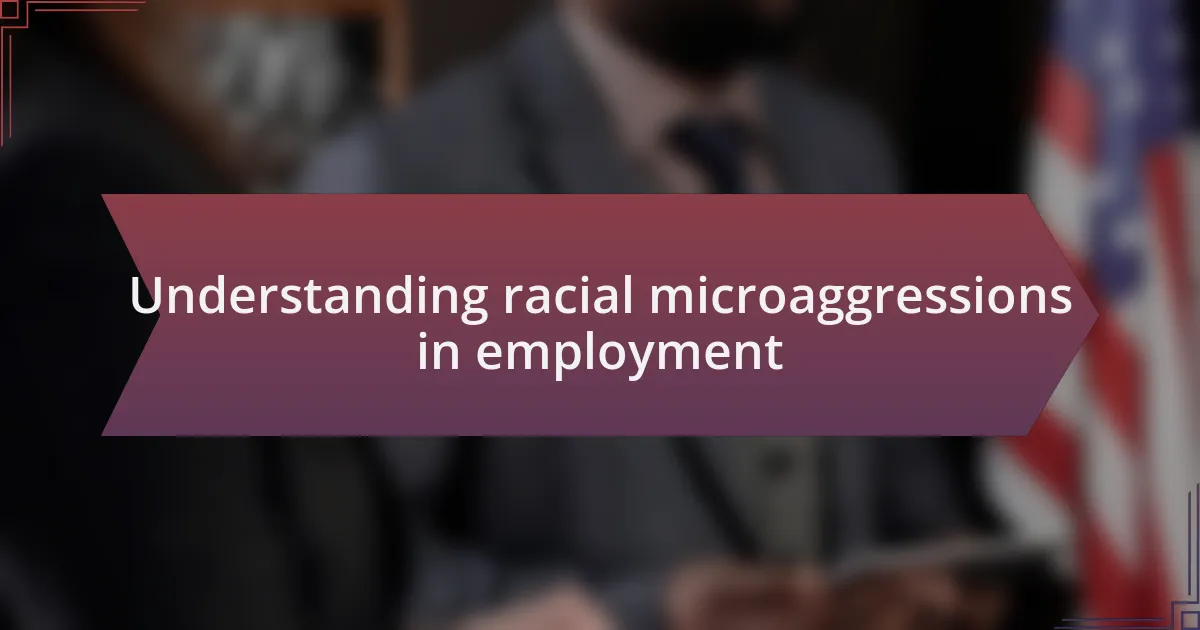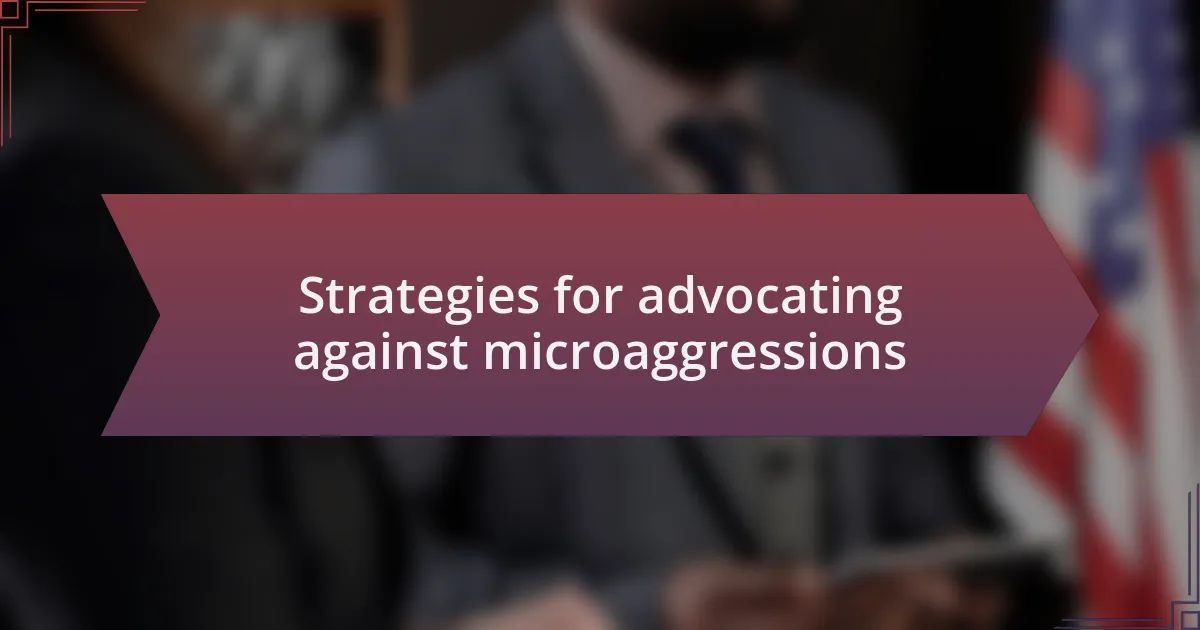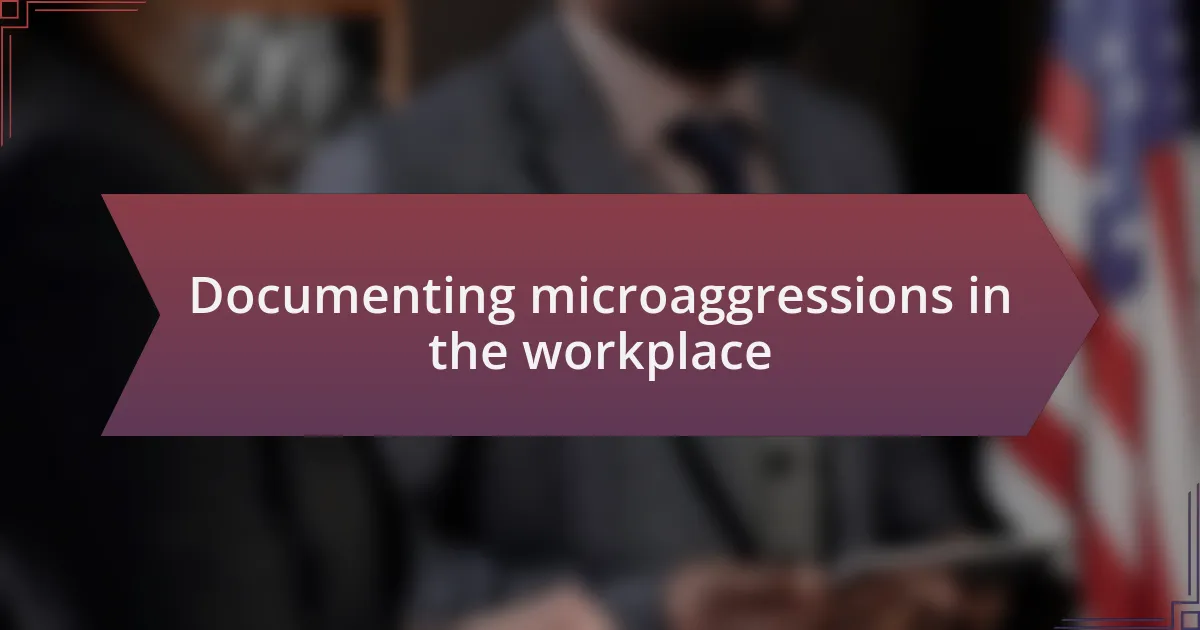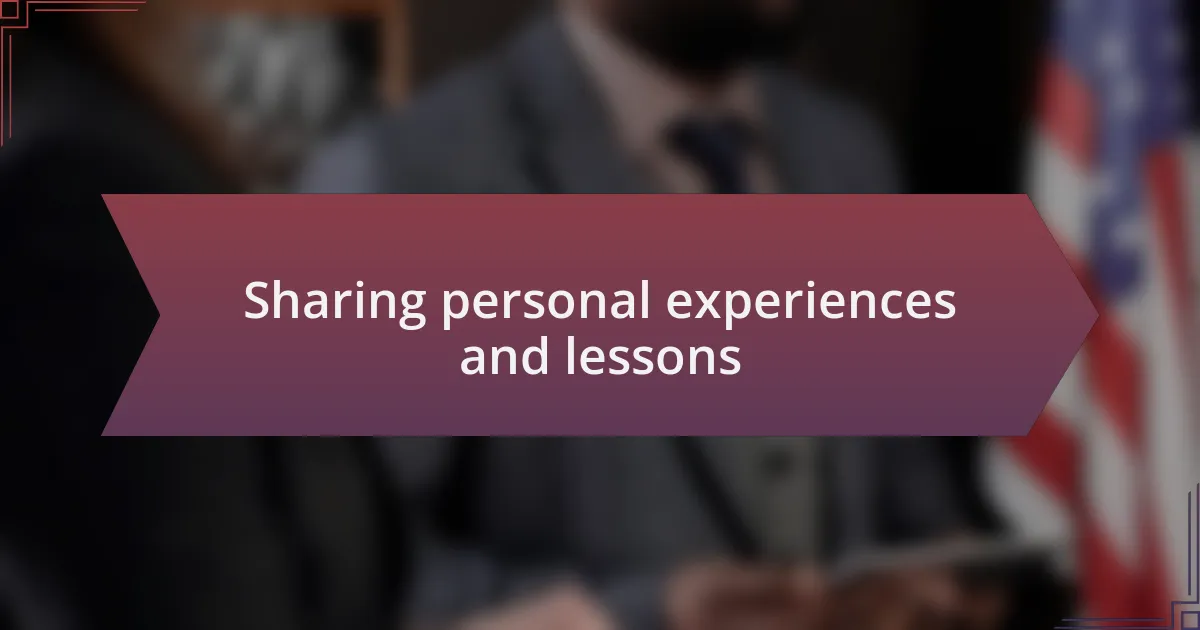Key takeaways:
- Racial microaggressions in the workplace can undermine professional merit and create a toxic environment, emphasizing the need for awareness and open dialogue.
- Legal protections, such as the Civil Rights Act, are essential but must be complemented by training programs and cultural initiatives to effectively combat microaggressions.
- Documenting microaggressions and sharing experiences with colleagues can empower individuals and strengthen the case for addressing bias in the workplace.
- Promoting inclusivity involves fostering open conversations and leading by example, allowing diverse voices to contribute and enhancing understanding among team members.

Understanding racial microaggressions in employment
Racial microaggressions often manifest in subtle ways within the workplace, such as comments that question competence or imply doubt based on race. I recall a time when a colleague remarked, “You speak so well for someone from your background.” At that moment, I felt a mix of anger and sadness; such remarks diminish one’s professional merit and can create a toxic environment.
These seemingly innocuous comments can erode an individual’s sense of belonging and can drastically impact morale. How often have you witnessed someone being overlooked for opportunities, not because of their skills, but due to underlying prejudices? It resonates deeply when we recognize that our workplaces should be spaces of equality, not arenas where subtle biases play out.
Understanding racial microaggressions isn’t just about identifying specific remarks; it’s about acknowledging the emotional weight they carry. I once overheard a manager dismiss an employee’s idea by attributing it to their ethnic background rather than their creativity. That moment reinforced for me the importance of having conversations about these biases in our organizations. It’s crucial we not only recognize these issues but also take steps toward meaningful change.

Legal frameworks addressing racial discrimination
Legal frameworks addressing racial discrimination form the foundation for creating equitable workplaces. The Civil Rights Act of 1964, particularly Title VII, prohibits employment discrimination based on race, color, religion, sex, or national origin. In my experience, understanding these legal protections can empower employees to stand up against microaggressions and promote a more inclusive atmosphere.
State and local laws often bolster federal protections, providing additional avenues for addressing workplace discrimination. For instance, I remember a colleague who successfully filed a complaint under state law after facing repeated microaggressions. It was a profound reminder that legal recourse exists, and it encourages others to speak up when they encounter bias.
It’s worth asking: how effective are these legal frameworks in addressing the subtleties of microaggressions? In my view, while laws are essential, they’re only part of the solution. There’s also the critical need for companies to adopt training programs and foster an open dialogue about diversity and inclusion. This combination of legal and cultural efforts is what I believe can truly mitigate the impacts of microaggressions in our workplaces.

Strategies for advocating against microaggressions
When it comes to advocating against microaggressions, one effective strategy is to create safe spaces for open discussions. I recall participating in a group meeting where employees were encouraged to share their experiences. This initiative not only helped surface subtle biases but also reminded us all of the shared responsibility in maintaining a respectful workplace. Have you ever noticed how voices often go unheard? By providing a platform, we empower individuals to express their feelings and experiences.
Another approach involves developing training programs that incorporate real-life scenarios and role-playing. I once facilitated a session that dealt specifically with microaggressions. Watching participants grapple with the impact of their words was revealing. It made me realize that understanding plays a crucial role in preventing these incidents. How often do we consider the unintended consequences of our actions? Emphasizing empathy can lead to more considerate interactions.
Lastly, advocating for clear reporting mechanisms is vital. When I faced microaggressions, I appreciated when my company had an accessible process in place for reporting incidents. I found reassurance in knowing that my voice would lead to tangible action. But, what makes a reporting system truly effective? For me, it’s about transparency and response. When people see that their concerns are taken seriously, it fosters trust and encourages others to come forward when they encounter similar issues.

Documenting microaggressions in the workplace
To effectively document microaggressions in the workplace, it’s essential to keep a detailed record of incidents. I remember using a simple notebook to jot down specific remarks or actions that felt off. This made it easier to identify patterns over time. Have you ever thought about how recalling these instances can actively validate your feelings? By capturing these moments, you not only hold onto your experiences but also equip yourself to address them with clarity.
In many cases, sharing documentation with a trusted colleague can add weight to your concerns. I found comfort when a co-worker and I exchanged notes on microaggressions we encountered. It was eye-opening to see how our experiences, though different, resonated with one another. Wouldn’t it be powerful to have allies when facing these challenges? By joining forces, we can tackle issues together, making it clear that these behaviors are not isolated or acceptable.
Moreover, consider the impact of formal documentation when submitting complaints to HR. There was a time when I approached human resources armed with my detailed notes, and it made a significant difference in how they addressed the situation. What if you had irrefutable evidence to support your claims? An organized account not only demonstrates the validity of your concerns but also underscores the need for systemic change within the organization.

Sharing personal experiences and lessons
Sharing personal experiences can be a powerful way to highlight the effects of microaggressions. For instance, I vividly remember a time when a colleague made a comment about my accent, implying it undermined my professional abilities. This incident lingered in my mind, creating a sense of doubt about how others perceived me. Have you ever had a moment like that where a simple remark shook your confidence? Reflecting on these experiences helped me realize how crucial it is to voice our feelings and educate others about their impact.
When I started sharing my stories in team meetings, I was surprised by the solidarity I found. I shared an experience where I felt sidelined in a discussion, and to my surprise, several others opened up about similar frustrations. It felt liberating to connect through these shared experiences. How often do we underestimate the power of collective voices? I learned that each story contributes to a greater understanding and brings the issue of microaggressions to the forefront of workplace conversations.
From these interactions, I’ve gathered invaluable lessons about advocacy. One standout moment was when my team collectively addressed a recurring microaggression during a project review. We presented a united front, advocating for a more inclusive dialogue. It taught me that while one voice can spark a conversation, many voices together create a movement. Have you thought about the difference it makes when we stand together against such behavior? I’ve seen firsthand that collaboration is key to fostering change and promoting a healthier work environment.

Promoting inclusive workplace environments
Creating an inclusive workplace isn’t just about policies; it’s about fostering a culture where everyone feels valued. I recall the time when my team organized a workshop on cultural sensitivity. During that session, people shared their backgrounds, leading to a deeper understanding among colleagues. Have you noticed how much richer conversations can become when individuals share their unique perspectives? It’s remarkable how these small steps can dismantle barriers and create a sense of belonging.
Encouraging open dialogue is also vital in promoting inclusivity. I once facilitated a discussion where team members could express their thoughts on workplace dynamics openly. Some were nervous at first, but once we started, the floodgates opened. Listening to others’ experiences illuminated biases I hadn’t even recognized in myself. How often do we miss opportunities to learn simply because we don’t create the space for honest conversation? Each insight received was a building block toward a more inclusive environment.
Moreover, it’s important to lead by example. I consciously make an effort to include everyone in discussions, especially those who are quieter. I remember one meeting where I specifically invited a shy teammate to share their thoughts. Their contribution was thought-provoking and added tremendous value, and that moment seemed to encourage them to speak up more often. Have you ever thought about the impact of just one encouraging word? Moments like these show that inclusivity thrives when we actively nurture it.